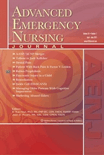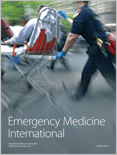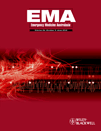
Advanced Emergency Nursing Journal
Scope & Guideline
Shaping the Future of Emergency Medicine Together
Introduction
Aims and Scopes
- Emergency Care Best Practices:
The journal emphasizes evidence-based practices in emergency care, offering insights into effective interventions and management strategies for various medical emergencies. - Patient Safety and Quality Improvement:
A core area of focus is the enhancement of patient safety and quality of care in emergency settings, including studies on triage, length of stay, and management protocols. - Diversity and Cultural Competence:
The journal highlights the importance of culturally competent care, addressing the needs of diverse populations and promoting inclusivity in emergency nursing practices. - Innovative Educational Strategies:
It encourages research on educational interventions aimed at improving the skills and knowledge of emergency nurses, including the integration of new technologies and training models. - Interprofessional Collaboration:
The journal supports studies that explore collaborative practices among healthcare professionals in emergency departments to optimize patient outcomes. - Emerging Health Issues:
Research on emerging health challenges, such as the impacts of pandemics or increased prevalence of certain conditions, is a key area, reflecting the evolving landscape of emergency care.
Trending and Emerging
- Mental Health in Emergency Care:
There is an increasing focus on the management of mental health crises in emergency settings, emphasizing the need for training and protocols to address the rising incidence of mental health emergencies. - Technological Integration in Emergency Nursing:
Emerging research is highlighting the use of technology, such as telehealth and point-of-care diagnostics, to enhance patient care and streamline emergency services. - Substance Use Disorders and Opioid Overdoses:
A significant trend is the exploration of strategies to manage substance use disorders, particularly in the context of the opioid crisis, reflecting urgent public health concerns. - Human Trafficking Awareness and Education:
There is a growing emphasis on the identification and management of human trafficking victims in emergency departments, highlighting the role of emergency nurses in this critical area. - Resilience and Burnout in Emergency Nursing:
Research focusing on resilience training and strategies to combat burnout among emergency nurses is gaining traction, acknowledging the high-stress nature of the field and its impact on healthcare providers.
Declining or Waning
- Traditional Emergency Procedures:
There has been a noticeable decrease in publications focused on traditional emergency procedures that were once common, such as basic airway management techniques, as the field evolves to incorporate more advanced technologies. - General Emergency Nursing Topics:
Broad topics related to emergency nursing that do not provide specific insights or innovations are becoming less frequent, suggesting a shift towards more specialized and evidence-based research. - Historical Perspectives on Emergency Care:
Papers that explore historical contexts or retrospective analyses of emergency care practices seem to be waning, indicating a preference for contemporary issues and forward-looking research. - Non-Emergency Specific Nursing Issues:
Publications that focus on nursing issues not directly related to emergency care, such as general nursing burnout without specific ties to the emergency setting, are less common, reflecting a more focused approach to the journal's core mission.
Similar Journals

Frontiers in Emergency Medicine
Advancing emergency care through innovative research.Frontiers in Emergency Medicine, published by Tehran University of Medical Sciences, stands as an essential open-access platform dedicated to advancing research and practice in the diverse fields of emergency medicine, nursing, and medical services. With a focus on publishing high-quality studies that address the emerging challenges in prehospital and emergency care settings, this journal has rapidly gained recognition since its inception in 2021. The journal's current Scopus rankings place it favorably within the top quartiles for emergency medical services and emergency nursing, making it a valuable resource for researchers and practitioners aiming to enhance patient care and operational efficiency in emergency contexts. The journal encourages submissions that explore innovative practices, clinical outcomes, and policy developments in emergency medicine, promising accessibility and visibility for authors through its open-access model. Located in Iran, Frontiers in Emergency Medicine not only serves the regional community but also aspires to impact the global discourse in emergency healthcare.

Open Access Emergency Medicine
Championing open access for a safer tomorrow in emergency care.Open Access Emergency Medicine, published by DOVE MEDICAL PRESS LTD, is a premier journal dedicated to the dynamic fields of Emergency Medicine and Emergency Nursing. With its ISSN 1179-1500, this journal has established a notable presence since its inception as an Open Access platform in 2010, offering unrestricted access to high-quality research and innovative practices in the area. As one of the leading journals in its field, it holds a respectable Q2 ranking in both Emergency Medicine and Emergency Nursing categories as of 2023, reflecting its commitment to advancing knowledge and fostering impactful research. The journal is indexed in prestigious databases with solid Scopus rankings, placing it in the 65th percentile for Emergency Medicine and the 64th percentile for Emergency Nursing, ensuring that contributions reach a diverse audience of researchers, practitioners, and students worldwide. With its focus on contemporary issues, this journal serves as an essential resource for the continual growth and development of emergency health services.

Emergency Medicine International
Empowering practitioners with vital insights in crisis intervention.Emergency Medicine International is a distinguished journal dedicated to the dynamic field of emergency medicine, published by HINDAWI LTD. As an Open Access journal since 2010, it ensures widespread dissemination of high-quality research, providing vital insights and advancements in emergency care and crisis intervention methodologies. With an ISSN of 2090-2840 and an E-ISSN of 2090-2859, the journal is indexed in Scopus, where it holds a commendable rank of #104 of 109 in the emergency medicine category, placing it in the 5th percentile. Spanning crucial years from 2014 to 2017 and 2022 to 2024, Emergency Medicine International has established a reputation for publishing significant findings that aid practitioners and researchers in improving emergency healthcare outcomes. Operating from its headquarters in Egypt, the journal serves as an essential resource for professionals and students alike, fostering the development of evidence-based practice in a critical area of healthcare.

Dimensions of Critical Care Nursing
Elevating Patient Care Through Evidence-Based InsightsDimensions of Critical Care Nursing, published by Lippincott Williams & Wilkins, is a premier journal dedicated to advancing the knowledge and practices within the fields of critical care and emergency nursing. With a distinguished history dating back to 1982, this journal plays a vital role in disseminating cutting-edge research, clinical advancements, and educational resources aimed at enhancing patient care in high-stakes environments. The journal is ranked in the Q2 quartile for both Critical Care Nursing and Emergency Nursing, reflecting its significant impact on the nursing field, with Scopus rankings placing it at #11 in Critical Care Nursing and #14 in Emergency Nursing. Targeting a multidisciplinary audience of researchers, clinicians, and students, the journal serves as a critical platform for discussions surrounding innovative patient care strategies, evidence-based practices, and emerging trends in critical nursing. Although it is not an open-access journal, it provides valuable insights that are essential for shaping the future of nursing practice. Stay informed on the latest research and contribute to the evolving landscape of critical and emergency care through Dimensions of Critical Care Nursing.

Internal and Emergency Medicine
Empowering Healthcare Professionals with Cutting-Edge KnowledgeInternal and Emergency Medicine is a highly regarded academic journal published by Springer-Verlag Italia SRL, dedicated to advancing the fields of emergency medicine and internal medicine. With an impressive Q1 ranking in Emergency Medicine and a Q2 ranking in Internal Medicine as of 2023, the journal serves as a vital platform for researchers and professionals alike seeking to disseminate pioneering findings and innovative practices. Established in 2006 and operational until 2024, the journal focuses on the intersection of these critical medical domains, providing insight into urgent clinical challenges and everyday internal medicine cases. Although currently not open access, it offers subscription options for readers aiming to deepen their knowledge in these essential areas of healthcare. The journal’s contributions are instrumental in shaping medical protocols and enriching the education of students and practitioners globally, all while based in the heart of Italy, specifically Milan.

Emergency Medicine Australasia
Advancing Emergency Care Through Research and InnovationEmergency Medicine Australasia, published by WILEY, stands as a premier journal in the field of emergency medicine, underlining its significance through its distinguished ranking as Q1 in Emergency Medicine and Q2 in Medicine (miscellaneous) as of 2023. The journal, which has been in circulation since 2004, provides a platform for high-quality research, clinical studies, and reviews that contribute to the advancements in emergency medicine practices. With a Scopus rank of 28 out of 109 in its category, it occupies a notable position within the medical community, boasting a 74th percentile ranking that reflects its impactful contributions to the field. Although it operates primarily on a subscription basis, Emergency Medicine Australasia is essential reading for researchers, practitioners, and students seeking to stay updated on the latest developments and methodologies in emergency care. This journal not only aims to disseminate critical knowledge but also fosters a collaborative environment for sharing innovations that improve patient outcomes and emergency services.

Journal of Pediatric Emergency and Intensive Care Medicine
Exploring the frontiers of intensive care in children.The Journal of Pediatric Emergency and Intensive Care Medicine, published by GALENOS PUBL HOUSE, is an emerging platform dedicated to advancing the fields of pediatric emergency care and intensive medicine. Established in Turkey, this journal strives to provide a comprehensive forum for the dissemination of innovative research and critical findings relevant to pediatric health, particularly within the emergency and intensive care contexts. Although it is currently categorized in Q4 quartiles across key disciplines such as Critical Care, Emergency Medicine, and Pediatrics, the journal seeks to evolve its impact by embracing high-quality submissions that contribute to best practices and effective patient outcomes in pediatric medicine. As an Open Access journal, it promotes the free sharing of knowledge, allowing accessibility for researchers and practitioners around the globe. Authors and readers can expect a rigorous peer-review process as well as a commitment to highlighting the most pressing issues facing pediatric healthcare today. Join us in advancing the dialogue in this vital sector of medical research.

African Journal of Emergency Medicine
Championing Excellence in Emergency Medicine and NursingAfrican Journal of Emergency Medicine, published by ELSEVIER, serves as a pivotal platform for disseminating innovative research and advancements in emergency medicine and critical care nursing. Launched in 2011, this Open Access journal has quickly garnered attention for its commitment to enhancing healthcare delivery across Africa, catering to a diverse audience of researchers, practitioners, and students. With an impressive rank of #44/109 in Emergency Medicine and positioning itself in the Q2 category for Critical Care Nursing and Emergency Nursing in 2023, the journal has established itself as a significant contributor to the medical community. The journal encourages the submission of high-quality research, reviews, and case reports that can inform clinical practices and emergency protocols across the continent. Its accessibility, reflected by its open access model, ensures that vital findings are available to those who need it most, thus fostering greater collaboration and innovation in emergency healthcare. With a focus on improving patient outcomes and advancing the field, the African Journal of Emergency Medicine is an essential resource for all who are committed to emergency care and related disciplines.

BMC EMERGENCY MEDICINE
Fostering collaboration in urgent and critical care.BMC Emergency Medicine is a premier, open-access journal that has been at the forefront of the field of emergency medicine since its inception in 2001. Published by BMC in the United Kingdom, this journal is distinguished by its impact factor and remarkable Q1 ranking in emergency medicine, placing it among the top-tier publications in this vital area of healthcare. With a current Scopus rank of #30 out of 109 in the category of Emergency Medicine, and occupying the 72nd percentile, BMC Emergency Medicine is a leading platform for researchers and practitioners alike to disseminate their findings related to urgent and critical care. The journal embraces a broad scope within emergency medicine, encouraging submissions on a wide range of topics including clinical practice, innovative techniques, public health, and policy issues that critically affect emergency care. The open-access model ensures that high-quality research is readily available to the global community, fostering collaboration and advancing knowledge in the field. For those dedicated to improving patient outcomes in emergency settings, BMC Emergency Medicine represents an invaluable resource and community.

Hong Kong Journal of Emergency Medicine
Connecting Research and Practice in Critical CareThe Hong Kong Journal of Emergency Medicine, published by WILEY, stands as a vital resource in the field of Emergency Medicine since its inception in 2004. With a commitment to advancing clinical practice and research, this open access journal—transitioned to open access in 2018—facilitates the dissemination of crucial knowledge among healthcare professionals and researchers, fostering a collaborative environment for addressing urgent medical challenges. The journal boasts an impressive impact factor and holds a Q2 ranking in the Emergency Medicine category for 2023, reflecting its significance and influence within the academic community. Located in Hong Kong, this journal aims to explore a broad spectrum of topics related to emergency and critical care, making it an essential publication for those seeking to enhance their understanding and practice in this fast-evolving field. Accessible through ISSN: 1024-9079 and E-ISSN: 2309-5407, it promises to be an invaluable asset for researchers, practitioners, and students alike.